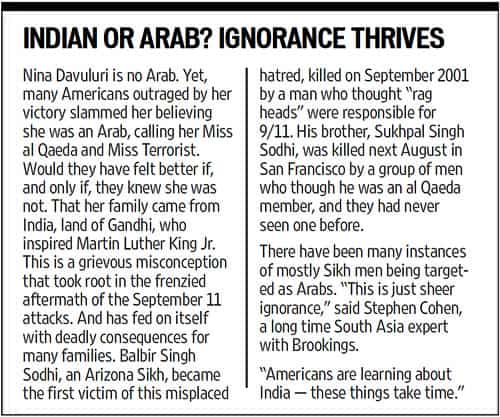But can Indians afford to outrage?
While racist slurs flew thick and fast in America when Indian American Nina Davuluri won the Miss America title, back home too, people had a lot to say.
While racist slurs flew thick and fast in America when Indian American Nina Davuluri won the Miss America title, back home too, people had a lot to say.

Online, the popular opinion in India too was that Nina is “too Indian” to be ever Miss India.
In India, skin colour is described by many as a national obsession, and ‘you likely wouldn’t see someone of her complexion in a pageant, much less winning one’, was a point raised often — and one that came as much from Americans as from Indians themselves.
But while there were ample tweets like “Indians prefer their beauty queens vanilla, preferably accessorised with blue contact lenses” circulating, some came to India’s defence giving examples of former beauty pageant winners Sushmita Sen, Priyanka Chopra, Lara Dutta, with skin tones on the darker side, making to the top.
While prejudice based on skin colour is an accusation Indians have faced off and on, it again came to the fore with the crowning of Davuluri in the USA.
The subtext this time: why expect anyone else to celebrate differences when your own house is not in order?
The answer, as often happens with most social-media fuelled debates, lies somewhere in the middle.
While classified ads in matrimonial sections proclaiming a preference for “fair complexion” brides and the popularity of skin whitening creams have borne testimony to the fairness fixation of Indians, things are changing in cosmopolitan India.
Says social scientist Shiv Visvanathan, “The Indian diaspora and the population back home do share certain biases related to caste and colour. Whereas ethnicity and colour maybe less than racial they have their own set of biases and bring in a cultural divide. In various cases upward mobility in society is related to the fairer skin. Resentment comes from both elite and middle classes based on colour and ethnicity and less from the lower classes.”

There have been efforts to change mind-sets, particularly from the glamour industry — held responsible by many for promoting regressive stereotypes.
While the ‘fair and lovely’ myth has endured in advertising and mainstream cinema, this year saw a campaign like ‘Dark is Beautiful’ featuring the dusky actor director, Nandita Das.
Even as the dark/fair fixation debate continues, some findings support that things are changing.
According to the research firm, Nielsen, the fairness product market has slowed down in value and sales over lately — the ` 2,940-crore fairness cream and lotion market saw a negative growth of 4.5% in sales volumes over a year ago, according to Nielsen’s moving annual total sales for the year till June this year — a significant change from a the last couple of years.
Says Navin Taneja, Director, The National Skin Centre, Delhi, “In 21 years of practice, I’ve seen fairness being a fixation but I’ve noticed that people have started letting go.
People demand what they see but now there has been a noticeable acceptance of beauty in various forms and also the confidence lies somewhere else.”





